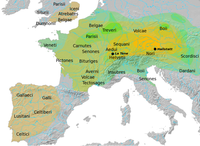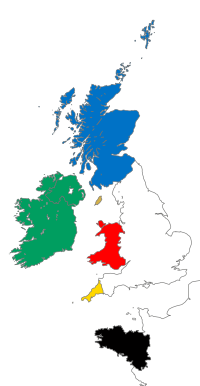-
Use Cases
-
Resources
-
Pricing
Proto-Celtic Language
Celtic Origins in Bell Beaker Culture
3000 BC - 2001 BC
% complete
Martín Almagro Gorbea proposed that Celtic arose in the 3rd millennium BC, suggesting that the spread of the Bell Beaker culture explained the wide dispersion of the Celts throughout western Europe.
Image source: Bell Beaker culture

Celtic Spread with Bell Beaker Culture
3000 BC
% complete
Cunliffe proposes that proto-Celtic had arisen in the Atlantic zone even earlier, by 3000 BC, and spread eastwards with the Bell Beaker culture over the following millennium, influencing the early development of Celtic culture and language.
Proto-Celtic Language Emerges
1200 BC
% complete
The traditional 'Celtic from the East' theory suggests that the proto-Celtic language arose in the late Bronze Age Urnfield culture of central Europe, around 1200 BC.
Image source: Proto-Celtic language

Urnfield Culture Flourishes
1200 BC - 500 BC
% complete
The Urnfield culture, named after grave sites in southern Germany, flourished from around 1200 BC to 500 BC, contributing to the development of the proto-Celtic language.
Image source: Urnfield culture

Lepontic Inscriptions
600 BC - 599 BC
% complete
The earliest undisputed examples of Celtic language are the Lepontic inscriptions from the 6th century BC, providing crucial evidence of early Celtic language usage.
Image source: Lepontic language

Urnfield-Hallstatt Theory
1900 - 1999
% complete
The Urnfield-Hallstatt theory, prevalent during the twentieth century, proposed the origin of the Celts and the proto-Celtic language out of the Urnfield culture of central Europe around 1000 BC.
Challenges to Urnfield-Hallstatt Theory
1900 - 1999
% complete
The Urnfield-Hallstatt theory began to be challenged in the latter 20th century, leading to a reevaluation of the origins and development of the Celtic culture and language.
Image source: Celts

Celtic Settlements
Hallstatt Culture Rich Grave Finds
1200 BC - 500 BC
% complete
The Hallstatt culture, known for its rich grave finds in Hallstatt, Austria, was prominent from around 1200 BC to 500 BC, contributing to early Celtic settlements.
La Tène Culture Development
500 BC - 1 BC
% complete
The La Tène culture, following the Hallstatt culture, developed from 500 BC to 1 BC, playing a significant role in the expansion of Celtic settlements.
Image source: La Tène culture

Celtic Settlement in Southeast Europe
300 BC - 299 BC
% complete
Celtic culture reached as far east as central Anatolia, Turkey, following the Celtic settlement of Southeast Europe in the 3rd century BC.
Image source: Celtic settlement of Southeast Europe

Celtic Identity
Herodotus Mentions Keltoi
500 BC - 499 BC
% complete
In the fifth century BC, Herodotus referred to Keltoi living around the source of the Danube and in the far west of Europe, contributing to early mentions of Celtic identity.
Image source: Herodotus

Gallia as Celtic Ethnic Name
500 BC - 499 BC
% complete
A Latin name for the Gauls, Galli (pl.), may come from a Celtic ethnic name, possibly borrowed into Latin during the Celtic expansion into Italy from the early fifth century BC.
Image source: Gauls

Greeks Coin 'Celtic' Name
100 BC - 099 BC
% complete
In the first century BC, Roman leader Julius Caesar reported that the Gauls called themselves 'Celts', influencing the adoption of the 'Celtic' name.
Celtic Territories in Roman Empire
1 AD - 99 AD
% complete
By the 1st century AD, most Celtic territories had become part of the Roman Empire, influencing the cultural identity and interactions of Celtic communities.
Image source: Roman Empire

Cohesive Celtic Cultural Entity Emerges
400 - 799
% complete
Between the 5th and 8th centuries, the Celtic-speaking communities in Atlantic regions emerged as a reasonably cohesive cultural entity, shaping the modern Celtic identity.
Modern Use of 'Celtic' Name
1700
% complete
For at least 1,000 years the name Celt was not used at all, until from about 1700, after the word 'Celtic' was rediscovered in classical texts, it was applied for the first time to the distinctive culture, history, traditions, and language of the modern Celtic nations.
Image source: Celtic nations

Edward Lhuyd Introduces 'Celtic'
1707
% complete
The English word 'Celt' is first attested in 1707 in the writing of Edward Lhuyd, marking a significant milestone in the recognition of the Celtic culture and history.
Image source: Edward Lhuyd

Celtic Literary Tradition
Insular Celtic Languages Attested
300 - 399
% complete
Insular Celtic languages are attested from the 4th century AD in Ogham inscriptions, marking the beginning of the written Celtic literary tradition.
Image source: Insular Celtic languages

Celtic Literary Tradition Begins
700 - 799
% complete
Celtic literary tradition begins with Old Irish texts around the 8th century AD, marking the emergence of a rich literary heritage within the Celtic culture.
Image source: Celtic literature

Key Facts
- Celtic people originated in Central Europe around 800 BCE.
- They were known for their skilled metalworking and artistic expression.
- The Celts expanded across Europe, reaching as far west as the British Isles and as far south as the Iberian Peninsula.
- Julius Caesar's conquest of Gaul in 58-50 BCE marked the beginning of the decline of Celtic independence.
- The final defeat of the Celts by the Romans at the Battle of Alesia in 52 BCE solidified Roman control over the Celtic territories.
Source
This Rise of the Celts timeline was generated with the help of AI using information found on the internet.
We strive to make these timelines as accurate as possible, but occasionally inaccurates slip in. If you notice anything amiss, let us know at [email protected] and we'll correct it for future visitors.
Create a timeline like this one for free
Preceden lets you create stunning timelines using AI or manually.
Customize your timeline with one of our low-cost paid plans
Export your timeline, add your own events, edit or remove AI-generated events, and much more
Free
$
0
free forever
No credit card required.
Basic
$
10
/month
billed annually
Cancel anytime.
Pro
$
16
/month
billed annually
Cancel anytime.
Common Questions
Can I cancel anytime?
Yes. You can cancel your subscription from your account page at anytime which will ensure you are not charged again. If you cancel you can still access your subscription for the full time period you paid for.
Will you send an annual renewal reminder?
Yes, we will email you a reminder prior to the annual renewal and will also email you a receipt.
Do you offer refunds?
Yes. You can email us within 15 days of any payment and we will issue you a full refund.
What if I have more questions?
Check out our pricing docs or send us an email anytime: [email protected].